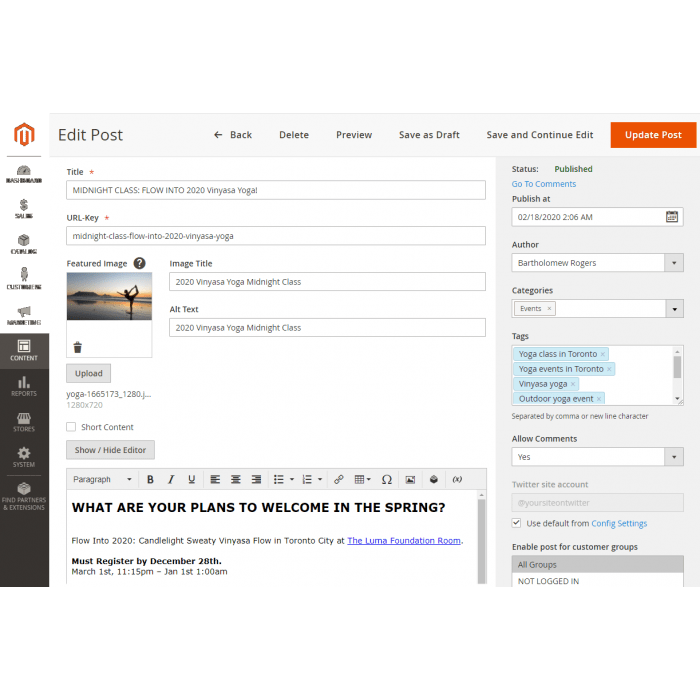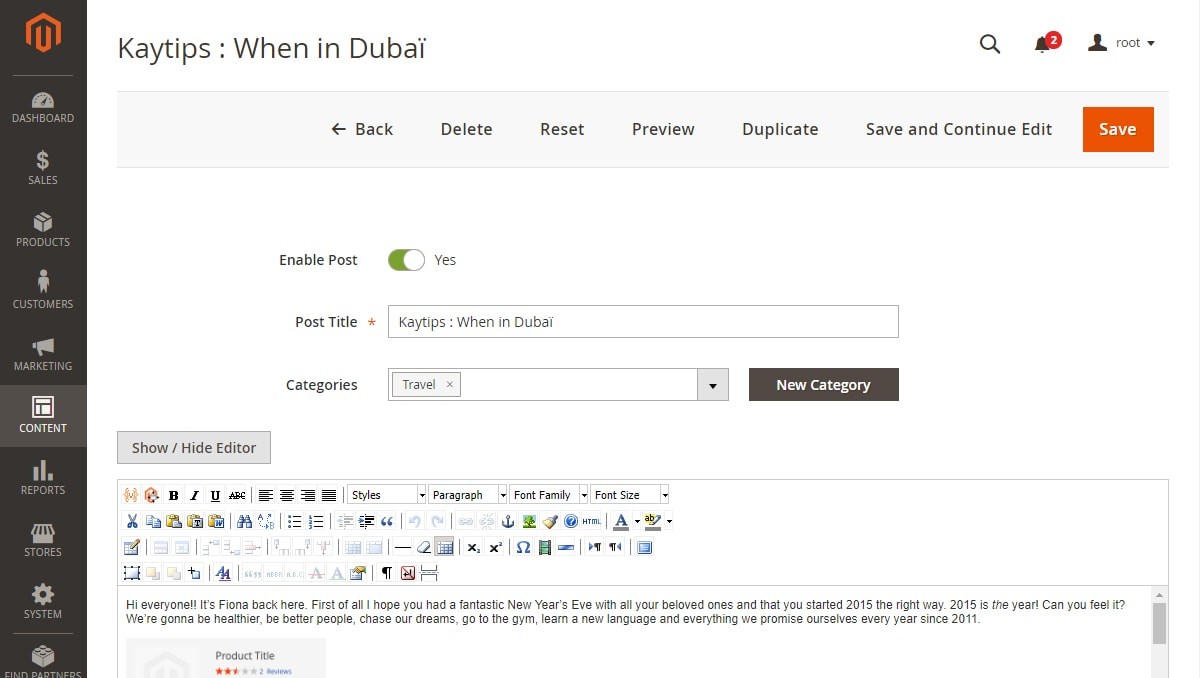Two Ways to Implement Magento eCommerce Blog. Which One to Choose?
eCommerce marketing blogs on Magento 2 boost site visibility and help rank higher on search engines to establish customer loyalty.
As judged by the Marketing Helpline statistics, blog posts are among the most shared content on the web, that’s why content marketing experts use blog content to improve their search engine optimization and attract organic traffic.
Why It’s Worth Implementing an eCommerce Blog into Your Store
The blog implemented into the ecommerce website could help you achieve the following business objectives:
- ✓ attract as much organic traffic as possible;
- ✓ improve website search engine optimization;
- ✓ boost an email subscribers list with relevant contacts;
- ✓ engage and interact with customers through valuable content;
- ✓ promote products and services and highlight their benefits through content;
- ✓ build a reliable and trustworthy reputation.
Now the small downside is that the Magento ecommerce platform doesn’t include blog functionality by default, but no need to worry; we’ve got you covered there. A blog could be introduced to the Magento 2 online store in two ways — using an extension or the most widespread blogging CMS: WordPress. Luckily for all of us involved here, the implementation process is relatively quick and painless, as this is quite a popular add-on solution.
Method #1: Using Magento 2 Blog Extensions
There’s a range of extensions on the market that could quickly implement blog functionality into almost any Magento store. But it’s also done in a striking enough way that helps preserve the unique design that’s already doing wonders for each ecommerce merchant. Their feature list isn’t quite as rich as a WordPress blog, but it’s more than adequate for ecommerce blogging and SEO. After it’s been implemented, blog sections will be displayed in the Magento 2 dashboard, making it super easy for your admin to manage.
Let’s have a closer look at a few well-made extensions we’ve had enough experience working with.
Blog Extensions to Implement into Your Magento Store
#1 Blog MX for Magento 2 by Mirasvit
This Magento 2 extension allows setting up SEO features and supports publishing material in images, videos, texts and provides users with an option to create tag clouds, preview posts, and pin them at the top of any given page. Posts can even be sorted by categories that are usually the fan-favorite of nearly any online store expanding their blogging footprint.
Price: $149-$448
Compatibility:
Magento 2 Open Source: 2.3. – 2.4.6
Adobe Commerce: 2.3. – 2.4.6
#2 Magento 2 Blog by AheadWorks
This solution offers a selection of advanced options in addition to some of the basics, such as scheduling publications, selecting posts that can only be displayed to certain users, and customizing the sidebar composition. It lists all posts in the sitemap.xml file to help web crawlers index pages smoothly and is also integrated with the Disqus service so that purchasers can leave comments on posts.
Price: $280
Compatibility:
Magento 2 Open Source: 2.4.4 – 2.4.6
Adobe Commerce: 2.4.4 – 2.4.6
#3 Magento 2 Blog Extension by Magefan
This one provides users with an option to use some of the most influential blog features for free like generating posts, categories, tags, comments, and authors that could be managed with a couple of clicks. You could also add related posts and products into the publications to create a better user experience or use best SEO practices, such as generating XML Sitemap, metadata, URLs, breadcrumb, or rich snippets.
Price: free
Compatibility:
Magento 2 Open Source: 2.3.0 – 2.4.6
Adobe Commerce: 2.3.0 – 2.4.6
#4 Magento 2 Blog Extension by Mageplaza
Mageplaza’s Magento 2 Better Blog extension offers a comprehensive range of features and benefits. The extension is API/GraphQL compatible, ensuring smooth integration and communication with other systems. Its PWA-ready solution ensures optimal performance on various devices. Plus, the built-in SEO features enhance the blog’s search engine visibility, while the ability to have multiselect categories and related posts on product pages provides improved navigation and user engagement.
Price: free
Compatibility:
Magento 2 Open Source: 2.3.0 – 2.4.6
Adobe Commerce: 2.3.0 – 2.4.6
Method #2: Integrating a WordPress blog into Magento 2 Store
WordPress, for those who don’t know, is a strong and effective content management system (CMS) designed for blogging. As stated in the Search Engine Journal, the WordPress share of the global CMS market reached 60.2%. WordPress allows for installing various themes, widgets, plugins, and galleries to enhance every aspect of customization and visualization. It has an extremely user-friendly interface, so managing content can’t be simpler and the best bet here is, you get full control over your website, and you can customize it in the way you want.
However, as great as WordPress is, there is a downside. Having a WordPress blog means you have two different platforms to maintain the blog and WordPress itself. While the two do work in perfect harmony together, it can occasionally cause additional paid modules and grow a necessity to keep a close eye on internet security to prevent malicious attacks.
You could take advantage of the FishPig extension that connects WordPress directly to the Magento 2 platform. The module allows flexibility, enabling the platforms to share a single theme or completely separate ones. FishPig also sells more advanced add-ons that extend WordPress functionality.
The bad news is that WordPress is still a vulnerable system. Knowing that a system like this is super popular and easy to use also means ease of access of all kinds. It’s something we all should be doing anyway but be sure to take a few extra precautions on your hosting server to protect your overall site.
WordPress Blog with Magento eCommerce
This alternative means launching a blog either on a separate domain or subdomain, rather than linking directly to your Magento 2 ecommerce website. Connecting a standalone blog with Magento 2 could be achieved with a little help of a WordPress blog link directly into your store on Magento 2. It’s simple to configure and could be placed in the header and/or footer area of a post or via the more complicated way of blog integration.
The upside here? It provides an option to apply all the WordPress features and create a unique design for your ecommerce blog. The great chunk here is that this type of integration won’t reduce your Magento 2 website security. Jokesters, pranksters, and cyber ninjas may be able to get past the WordPress piece, but they won’t be able to make it into the ecommerce platform.
But let’s talk about the disadvantages of the independent WordPress blog approach. At first, customers don’t see the icon of the shopping cart in the top header while scrolling. To see it again, they have to go back to the online store. It may not seem like a big issue, but small things like these have been proven to influence sales.
In this case, Magento 2 and WordPress act like completely different websites, so they keep other databases. Users have to sign up twice (to store and blog) to access all material, not exactly the best user experience model. To skirt the issue, a dedicated module can be put in place, but it is a rather expensive option for such a small impact.
Speaking of user experience, next comes search capabilities. The websites don’t share a typical search by default, so users who search for something on an online store will only see product results. To streamline these search results, two custom modules have to be developed and implemented. The first one for Magento 2, the other one for WordPress. Considering this option, keep in mind the overall developing process as it could become a bit costly and time-consuming.
Lastly, something to consider: having an independent blog on WordPress is the worst possible decision in the context of search engine optimization. Developing a website on a separate domain doesn’t attract many long-tail keyword traffic to the ecommerce website, which we all know by now, isn’t a good thing. And if it doesn’t boost keyword traffic, it doesn’t boost store ranking either. The only chance a WordPress blog on a separate domain (or subdomain) will have at helping your Magento 2 store is if users access the page via the links in the content that lead to the products on your store.
To sum up, this option is more trouble than it’s worth, so while we’re here to provide information for the sake of being unbiased, it’s not our favorite option.
Best eCommerce Blogs on Magento in Different Niches
#1 Nutrafol Blog
The hair growth supplement manufacturer has a minimalistic blog with articles devoted to health habits and lifestyle, common hair problems, and ways to get beautiful hair. The interesting fact is that they also generate some content connected with the product itself — successful stories, ingredients, and science beyond the hair supplements.
#1 Clean Origin Blog
An excellent illustration of an immersive blog is the collection of articles posted by a jewelry boutique Clean Origin. These captivating posts gather valuable insights on selecting the perfect diamonds, enthralling stories about the rich history of jewelry, and even offer relationship advice. The blog’s allure lies not only in its sophisticated appearance and user-friendly design but also in the compelling and relevant content that allows readers to delve deep into the fascinating world of the jewelry industry.
#3 RXBAR Blog
One of the tricks for food & beverage stores could be introducing unique recipes, as a US-based protein bars manufacturer did in their blog. All of the recipes are simple step-by-step guides that demonstrate how to introduce products into the daily routine and experiment with them in the kitchen.
#4 Antique Farmhouse Blog
Antique Farmhouse operates as an online store, specializing in timeless and high-quality home accessories for its customers. Their blog centers around a plethora of decor ideas, offering advice on crafting a simple yet cozy home interior and providing insights into color choices and home styles that epitomize perfection.
In their blog, Antique Farmhouse goes beyond merely promoting their products; they also passionately project their vision of cultivating a comfortable living environment within one’s home. By sharing their expertise, they demonstrate a genuine concern for their readers’ well-being and underline the care exhibited by the online store owners in curating a thoughtful and inspiring experience for their customers.
#5 VanMoof Blog
We’d also like to highlight the blog of the bike manufacturer and seller. Its content focuses on various topics — from cycling in different cities of the world to the brand’s internal sides, such as product news and its tech features.
Conclusion
The pool of ecommerce blog topics is endless – as well as your target audience interests. Some may find value in writing about product reviews, comparisons, and trends. Others may want to focus on promotions, top lists, and how-to articles. A blog, done right, can help in so many areas. Anything from helping communicate with consumers, connect a brand with a personality, serve as an echo chamber for client feedback, engage them in conversations with each other, and in some cases, even encourage others or themselves to buy products.
The key points you should consider when preparing to launch a blog are the frequency and length of posts. We might suggest setting up an extension for those who plan to publish short texts several times per week.
After you have a clear vision of adding a blog in Magento 2, we’d like to share some helpful statistics that might increase your blog efficiency. According to Omnicore, it’s better to post at least 16 times per month to maximize traffic, and articles should be between 1,000 and 1,500 words. Posts with images get 94% more views, whereas articles that include videos may increase by 157% traffic.
Hunting for Magento development support?
We’ll be in touch soon if you leave your contact information








